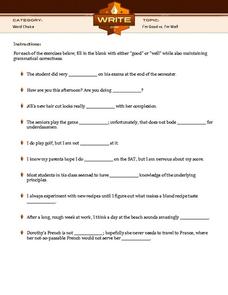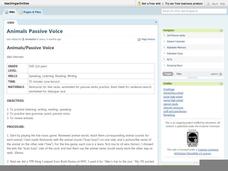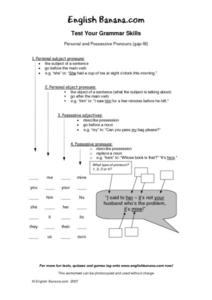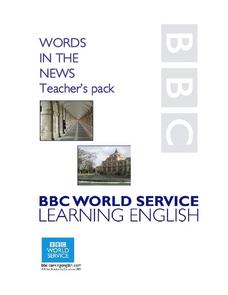John Talavera
Autism iHelp – Opposites
In/out, up/down, big/small; understanding opposites is a fundamental vocabulary-building skill. This app uses real-life photographs, to introduce the learner to the concept of opposites. Learning opposites is necessary for understanding...
Nazareth College
Chronological Order
First, next, and last, the elements of chronological order. In every story or text one can find a series of events that occur one after the other. To help learners with visual impairments conceptualize chronological order, this lesson...
Perkins School for the Blind
Rough or Soft?
When a child has some vision they need to be encouraged to use it in a positive and stimulating way. To better understand which types of tactile reinforcers your learner likes best; you'll rub different textured objects on his/her arm...
Write.com
Complement /Compliment
Have your pupils been mixing up the words complement and compliment? Set them straight with a brief lesson and then assign the quick activity included for some practice. Class members read each of 10 sentences and circle the correct word...
Write.com
Into vs. In To
Is it into or in to? Guide your pupils toward an understanding of the difference between these two words with a brief lesson accompanied by this activity. Class members are given 10 sentences that use either into or in to. They circle...
Write.com
Which vs. That
Show your class the difference between which and that with this basic and straightforward worksheet. Using the context of each sentence, learners circle the appropriate word choice. Assign this as a warm-up activity or a short homework...
Curated OER
I'm Good vs. I'm Well
How are you? Good? Well? Help your class figure out how to answer that question using proper grammar with the activity included here. You will need to teach a brief lesson before sending your pupils off to fill in each blank with either...
North Iowa
Identifying Kinds of Pronouns
Provide your ESL or ELA pupils with some skills practice for identifying various kinds of pronouns. Comprised of 40 problems and broken into four parts, pupils first underline all the pronouns in each sentence, then identify them as...
PB Works
Animal Sounds and Passive Voice
Originally designed by an American language teacher teaching in a public Japanese junior high, this lesson could easily be used for any beginning or intermediate level ESL class. With this plan, your class will review two useful, but...
English Banana
Test Your Grammar Skills: Personal and Possessive Pronouns (gap-fill)
Practice personal and possessive pronouns by filling in the blanks. Learners are given information about different types of pronouns and can use that information to fill out the instructional activity. Arrows help to clarify what...
Using English
Gender-Specific Vocabulary
Would you agree that certain words in the English language are typically used to describe women, while other words are used to describe men? To warm up, English language learners tell their partner about what they did over the weekend....
The New York Times
Fill-In | Valentine's Day
Learners read an editorial on Valentine's Day and either fill in the blanks with their own words, or try to place the words from the word bank in the correct spots. This may be useful for English learners.
Perkins School for the Blind
Chromosome Models- Karyotyping
Create your own karyotypes with clay in a kinesthetic genome activity. This tactile experience was created for visually impaired pupils, but can be used for all hands-on learners who are beginning to study chromosomes. The preparation...
BBC
Words In The News: Japan Textbook Back In Spotlight
High-interest articles are a great way to get struggling readers to tackle difficult vocabulary. Here is a activity that includes such an article. It is focused around a very interesting and controversial article about the teaching of...
Autism Inspiration
Why We Use Our Words
Here is a lesson designed for children with autism which is aimed at helping them understand that using their words to express what they need is an important social skill. They are charged with using their words to explain to the teacher...
Curated OER
Self-Portrait
Build a sense of self while honing prewriting and fine motor skills by having your learners with autism draw a self-portrait. The lesson is intended for younger pupils but could be used with learners of any age in need of motor and...
Curated OER
Purchasing Items Using “One-More-Than” Technique
While the method described to help learners with special needs is sound, it could create unforeseen issues. They are taught through structured practice, how to count out one dollar in coins and then add the dollar amount to it, to...
Curated OER
Home Living/Life Skills: Face Washing
Having good hygiene skills is a very important part of living an independent life. Learners with special needs follow sequencing cards to practice washing their faces. They follow each step in the process and discuss the importance of...
Curated OER
Youth and Old Age Vocabulary
In this youth and old age vocabulary learning exercise, students choose the vocabulary word that does not fit in each group of vocabulary words, all of which pertain to youth and old age.
Curated OER
Prepositions
In this prepositions learning exercise, students complete a 15 question multiple choice on-line interactive exercise about the correct use of prepositions in sentences.
Curated OER
Bronx Zoo
Students prepare for a field trip to the Bronx Zoo. They use maps and descriptions of animal exhibits to give and interpret directions on how to navigate the zoo. They play games, participate in pairwork and whole class discussion.
Curated OER
Question Formation
In this grammar and punctuation worksheet, students complete a ten question on-line interactive quiz. Students read a sentence and mark if it is correct or incorrect.
Curated OER
House Word Scrambles
In this ESL online interactive home worksheet, students answer 10 fill in the blank questions regarding things one would find in a house. Students may submit their answers to be scored.
Curated OER
Prepositions
English language learners and native speakers alike will benefit from this preposition review. Prepositions are defined, and then there is a practice opportunity provided that spans two slides.

























